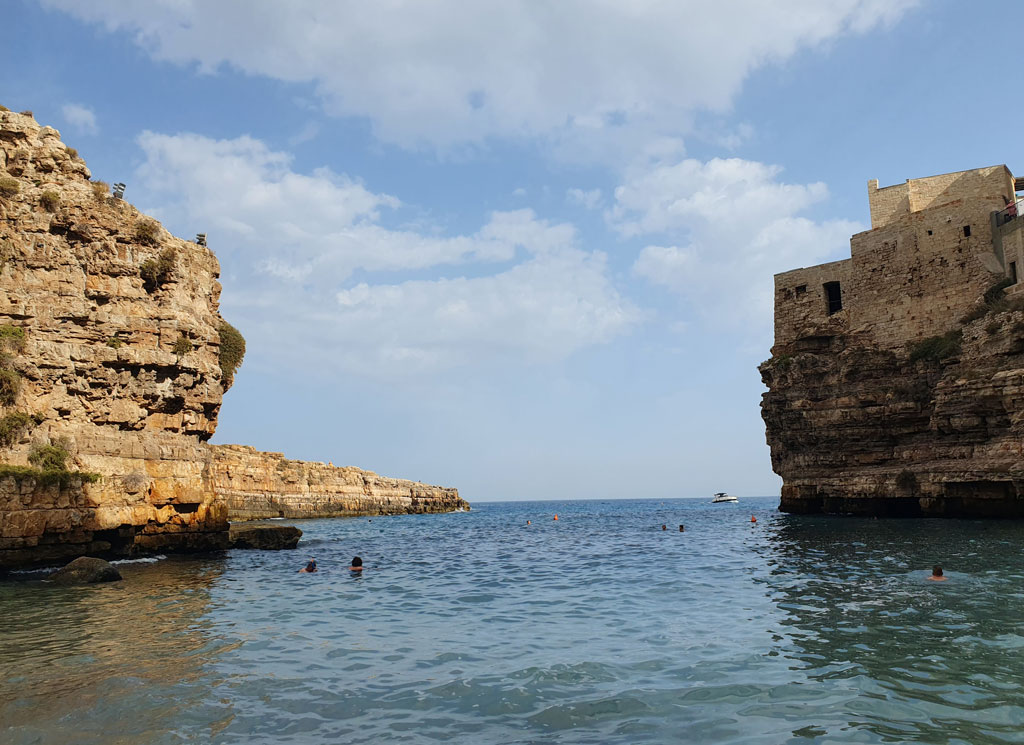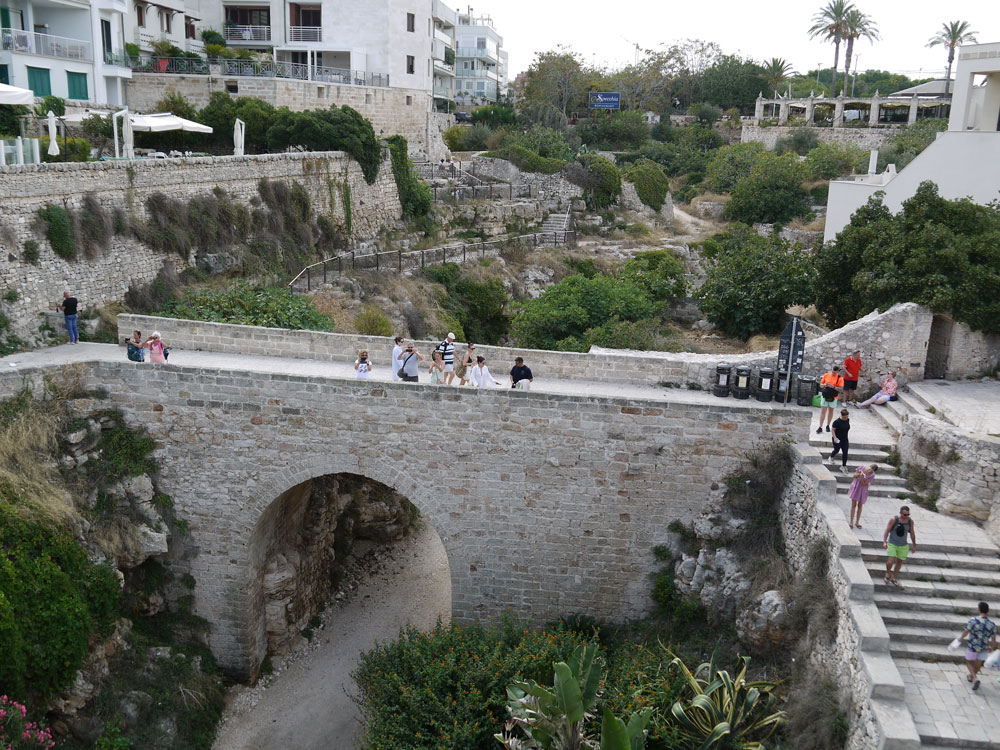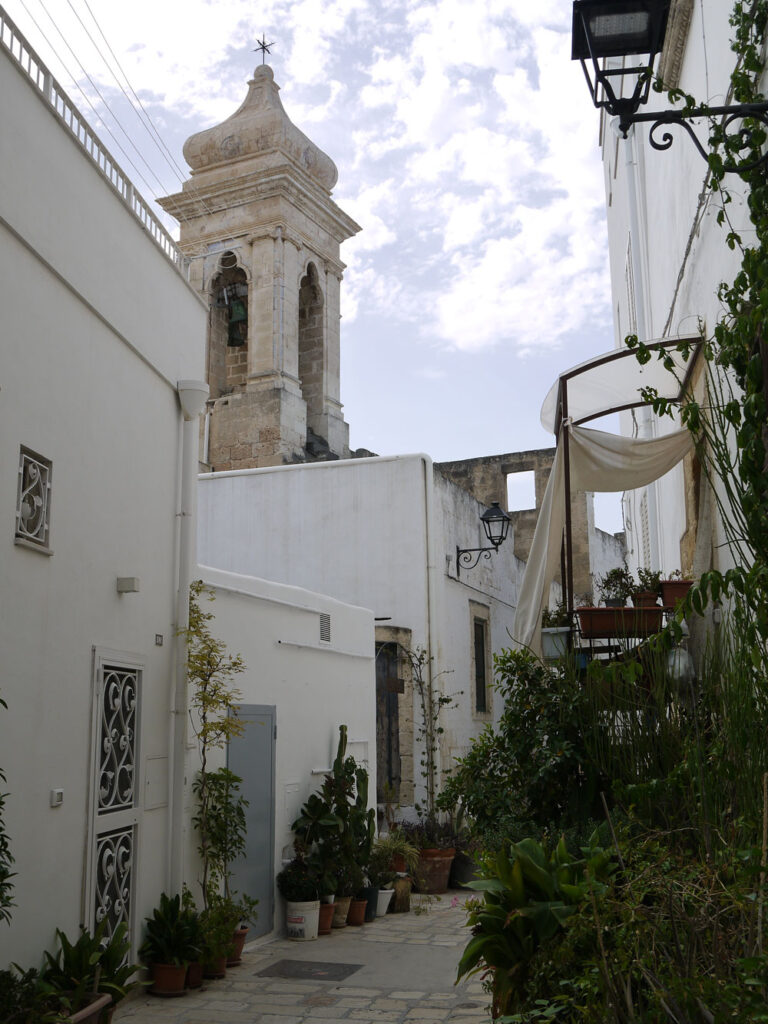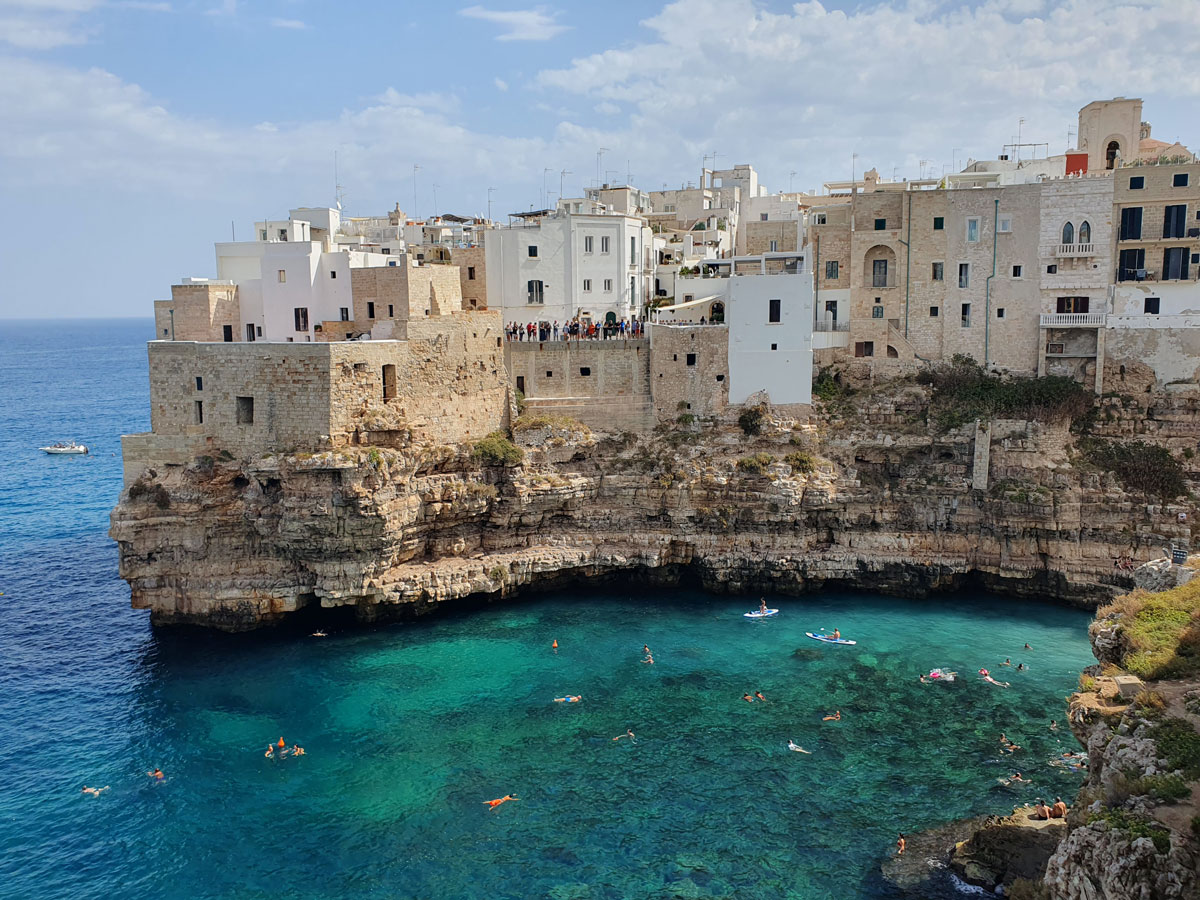Polignano a Mare is a charming clifftop town in Puglia with breathtaking scenery that’s led to an explosion in tourism. Photo-friendly and Insta-famous, Polignano has so far embraced its crowds of visitors. The narrow lanes of the pretty historic centre are lined with tourist-friendly places to eat, drink, stay and buy souvenirs. Buses bring day-trippers and tour groups (read on for my honest opinion of the atmosphere). Every year the Red Bull Cliff Diving Series holds a competitive event here – check out the videos of previous years for amazing daredevil feats and panoramic views.
Polignano tourist information
Polignano a Mare (the name is pronounced Polinyarno a Mahreh and means Polignano by the sea) is in the region of Puglia in southern Italy, 20 miles south-east of Bari. Situated on low cliffs overlooking the Adriatic sea, the historic town centre is made up of tightly winding lanes on a headland. Beyond the old defensive town walls is the modern town. Built from the 19th century onwards, this spreads out in a more orderly grid of streets, some of these still with period charm.
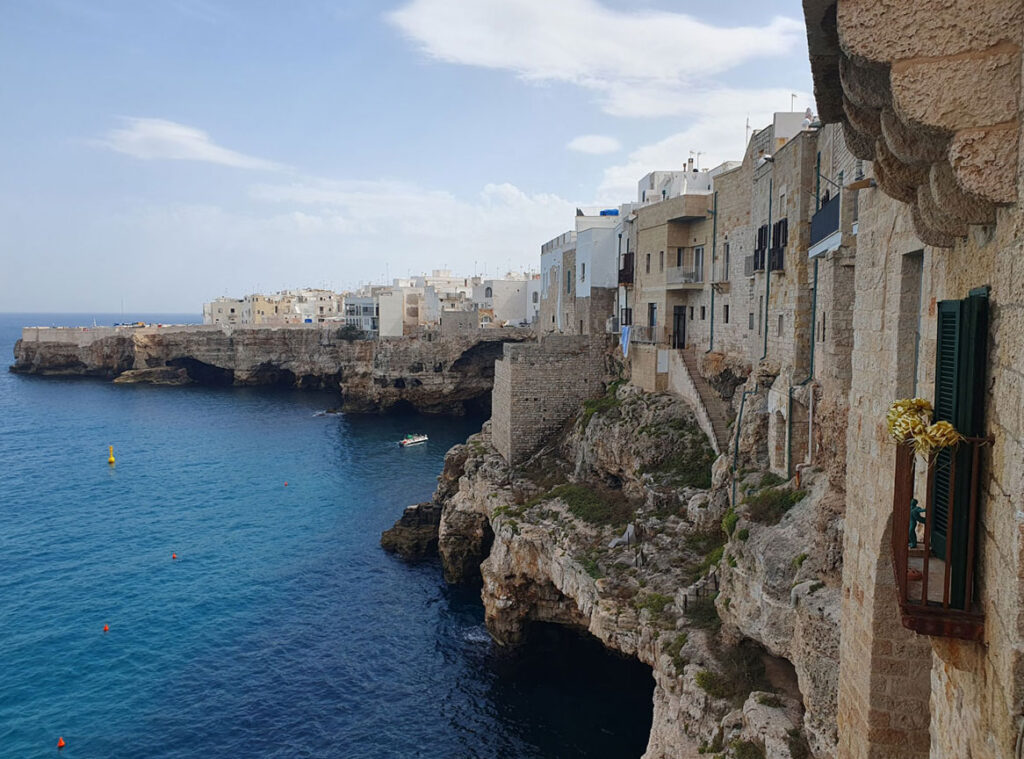
Lama Monachile – the famous view
Polignano’s biggest sight is Lama Monachile, a rocky bay between cliffs that was once used as a port – hence its other name, Cala Porto. The beach here is a popular spot for both swimming and sunbathing. Behind the beach a ravine cuts into the land, crossed by a pair of bridges, the smaller of which is known as the ‘Roman Bridge’ and is on the route of Trajan’s Roman road, the Via Traiana.
The beach can be reached by a couple of sloping and stepped routes, one on the other side of the road bridge, passing through its arch, and another from further along the road in the San Vito direction, away from the town centre. The beach surface is a mixture of mostly pebbles and stones, with some rough sand; I’d recommend wearing something to protect your feet. It gets crowded, and some sunbathers and adventurous would-be divers find places on the rocks nearby to spread their towels, or head further along the coast to quieter bathing spots. A short tunnel leads through the cliff to the sea beyond.
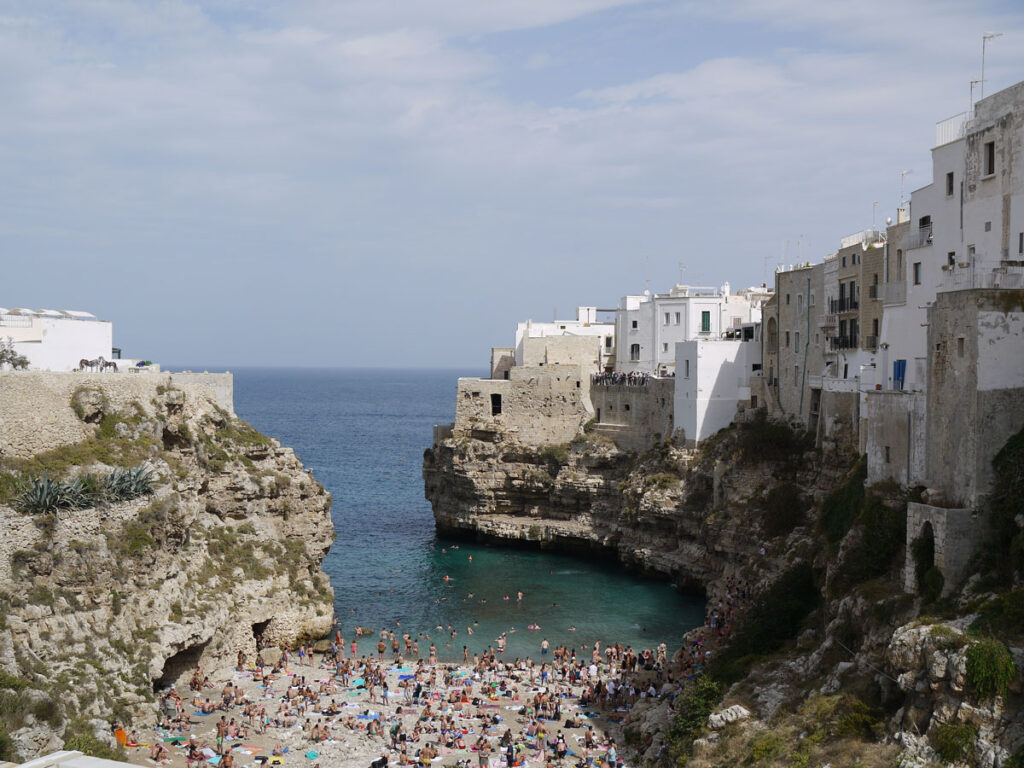
During the Red Bull Diving Series, diving platforms are erected on a private terrace on the town headland in front of the beach, with crowds gathering to watch.
There are wonderful views of the bay from a variety of viewpoints: the beach itself, the bridge at the back of the beach, a panoramic terrace in the old town, and from the headland beyond the bridge, near the much-visited statue of Domenico Modugno – more on this below.
Around the historic centre
Polignano’s historic centre, the centro storico, is typical of the handsome historic towns and villages of Puglia: a harmonious mixture of whitewash and pale stone. The town wears its long history lightly: there aren’t a great many specific sights or museums to visit. The best way to enjoy Polignano is just to stroll at your leisure and admire the charming haphazard architecture and the winding lanes.
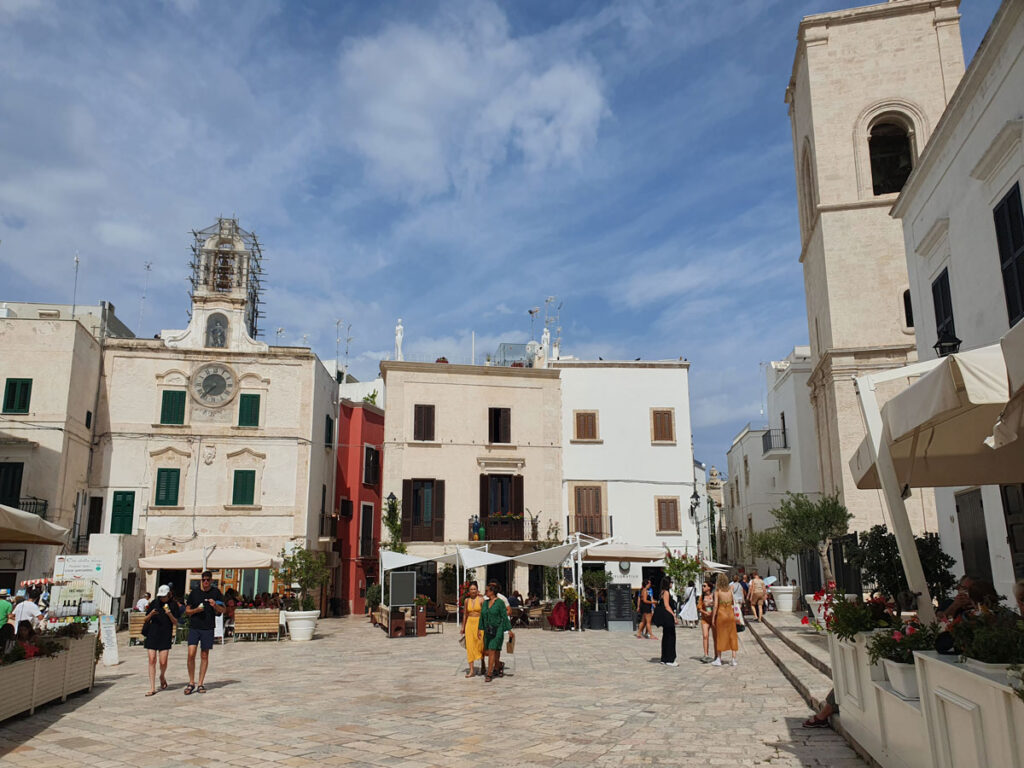
You can easily see Polignano’s sights in a day, with a visit to the Abbey of San Vito along the coast included. If you like the idea of a boat trip, leisurely meals and beach time as well as sightseeing and exploring, two days would allow for an enjoyable slow-paced experience. Further down this page I discuss using Polignano as a holiday base, public transport possibilities and the best places to stay.
A good place to start is the town tourist information office (Info Point Turistico), just outside the old town on Via Martiri di Dogali. Here you can pick up a map and any timetables or information that will enable you to get the most from your time in Polignano. There’s a public toilet around the corner.
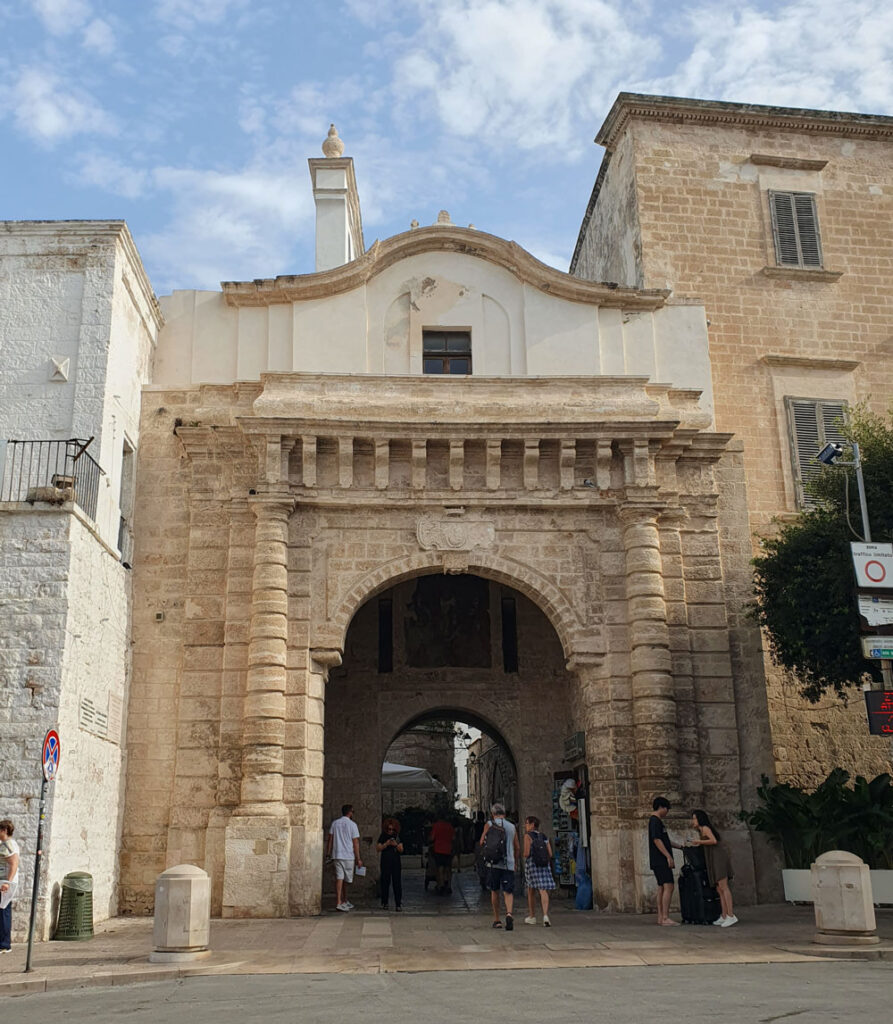
The principal and most impressive entrance to the old town, once the only way in through the town walls, is the Arco Marchesale, also known as the Porta Grande. This historic town gateway is just a few yards along the road from Lama Monachile; this is a compact town to explore.
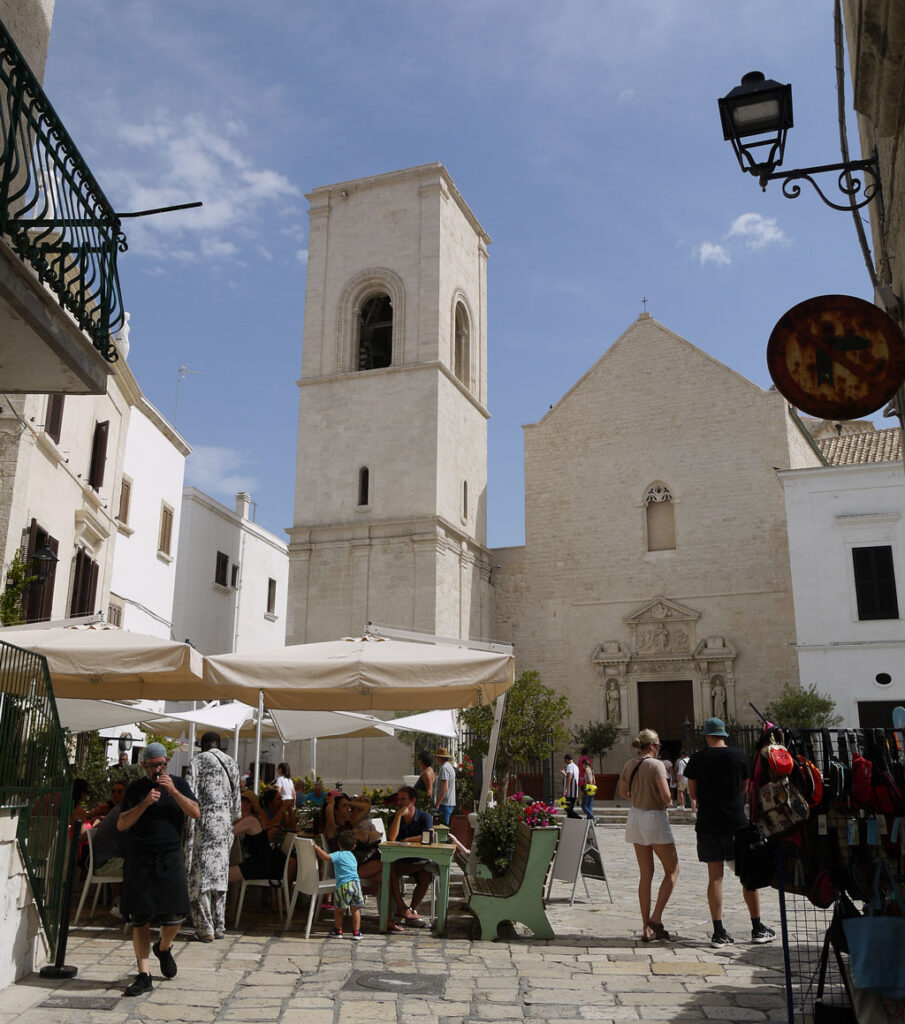
Heading straight on inside the gateway you’ll arrive in the old town’s heart, Piazza Vittorio Emanuele II. The square is lined with restaurant tables, and dominated by Polignano’s mother church, Santa Maria Assunta, the Chiesa Madre or Matrice. This relatively modest church was originally consecrated in the 13th century; the interior is mostly 16th century and contains some fine sculptures as well as a 15th-century polyptych of the Madonna and Saints by Venetian artist Bartolomeo Vivarini.
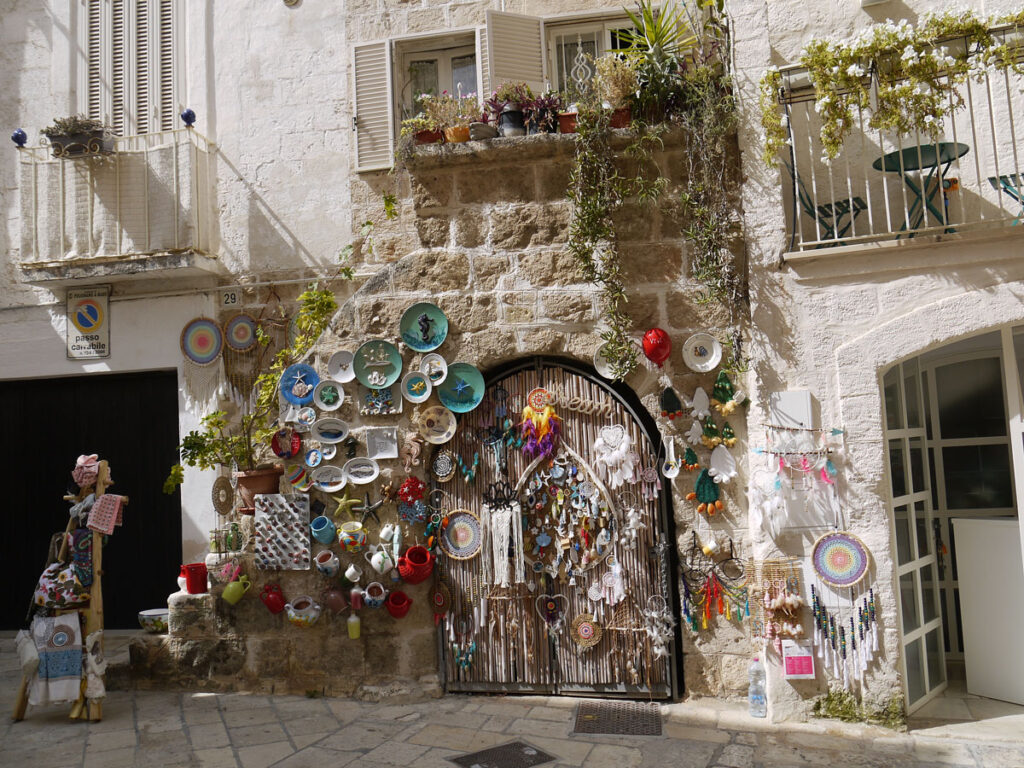
Among colourful little boutiques selling arts, handicrafts and souvenirs, residents have adorned the walls with painting, poetry and other decorations, while plant pots edge steps and green leaves trail down over stonework. A highlight for explorers is emerging onto panoramic terraces with views along the cliffs or down to the beach at Lama Monachile.
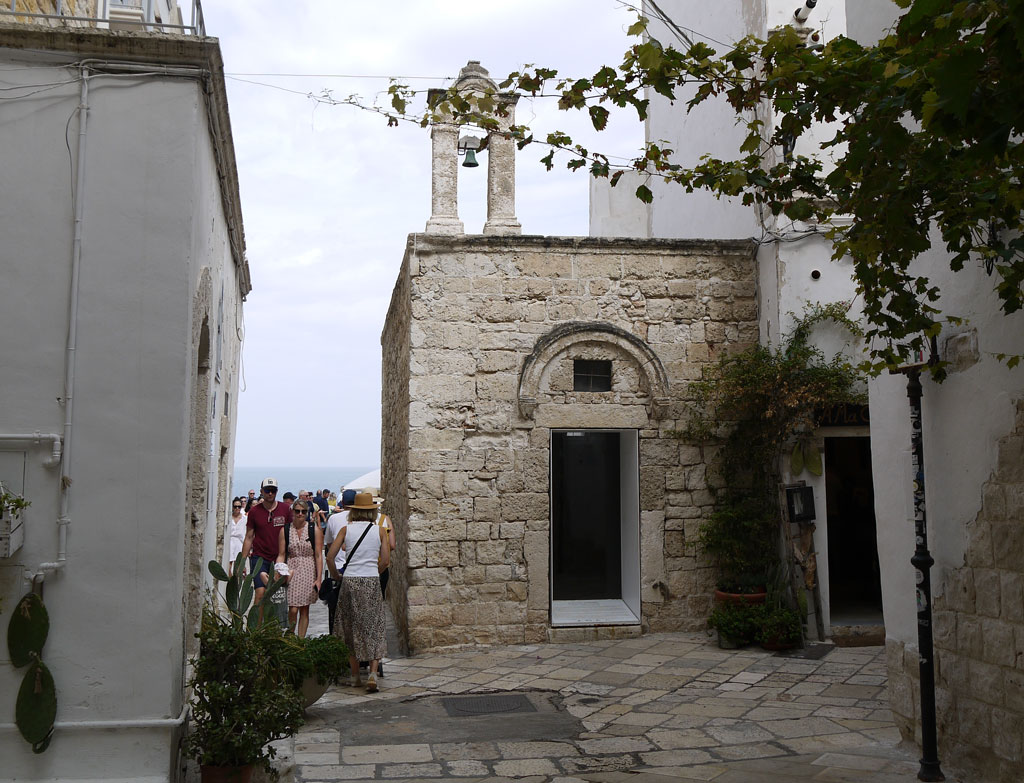
Away from the busiest spots, the white amphitheatre-like Piazza San Benedetto is the centro storico‘s second piazza. From here you can head out towards the more modern street grid of the newer town, or follow picturesque winding lanes leading back inside the old walls towards Piazza Vittorio Emanuele.
If you’d like to fit some contemporary art into your day, you could take a walk to the Museo Pino Pascali, named in honour of the Puglia-born artist Pino Pascali (1935-1968). As well as a permanent collection, the museum houses temporary exhibitions. The setting is in a former abattoir on the seafront outside the historic centre. Check the opening days/times.
The low cliffs on which Polignano is built are honeycombed with caves. You can admire more of the coast from viewpoints along the seafront to the south-east of the town centre – or by taking a boat trip to tour the coastline and caves.
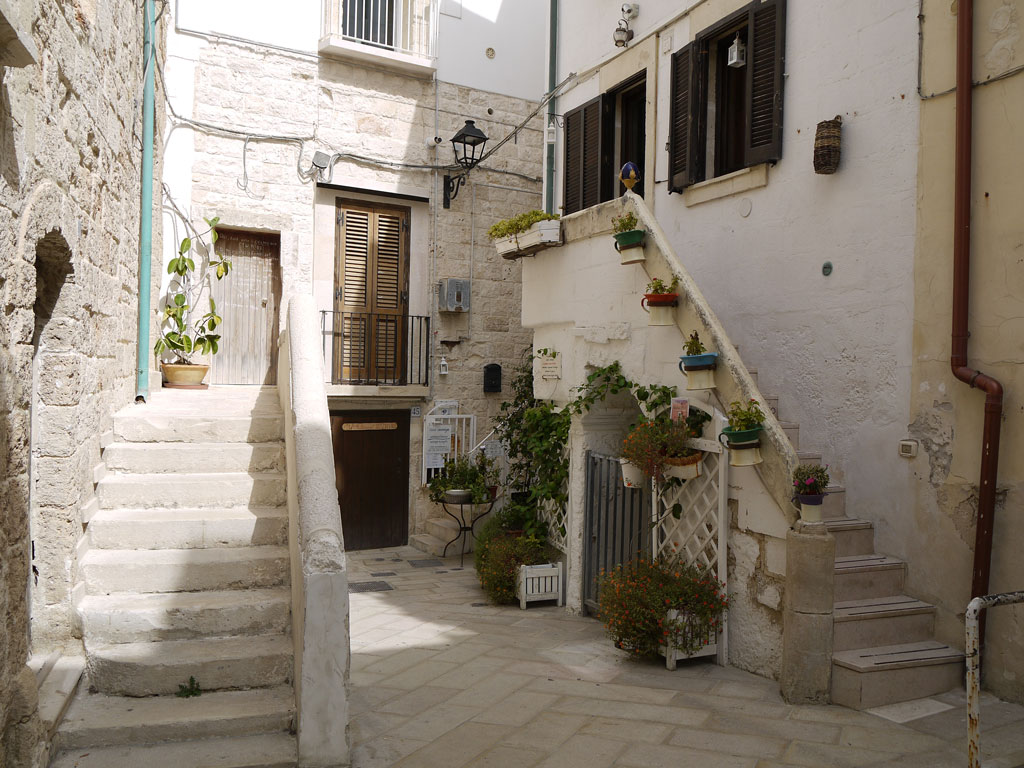
Boat tours
Boat tours of the shoreline make a fun way to enjoy another perspective on the Polignano scenery, as well as getting out onto the water. Most boat trips depart from the Abbazio di San Vito, a couple of miles along the coast (though a few start at certain times of year from Cala Paura, closer to the town centre). San Vito is a short drive to the north-west of town. Car-free travellers can reach San Vito by taking one of the town’s little three-wheeled taxis, cycling or walking. I’ve written more about getting there and back: Abbey of San Vito.
Check that boat trips are running before setting off – I’d suggest getting the latest, up-to-date details and recommendations from the tourist information office or your local accommodation; though you can also book online in advance. Firms offering boat trips include: Polignano in Mare Escursioni, Dorino Gite in Barca, Blue Moon Escursioni.
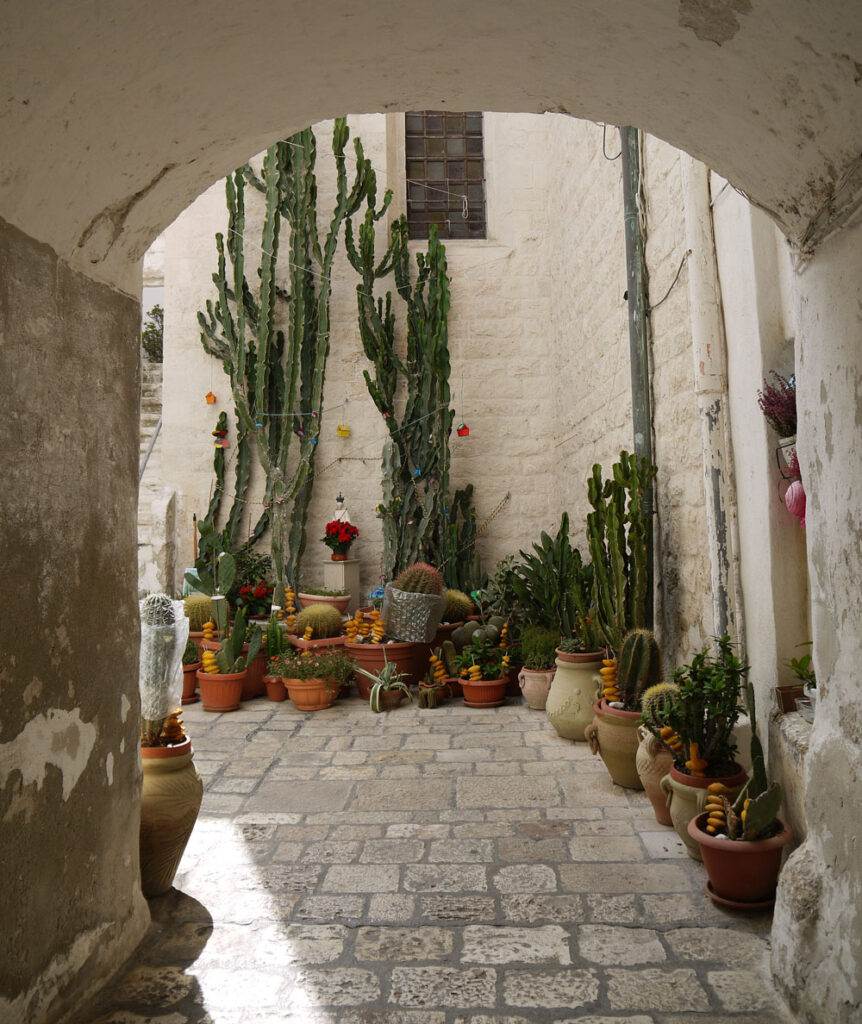
Nel blu, dipinto di blu
Domenico Modugno may not be a household name in the English-speaking world, but most travellers will be familiar with this singer-songwriter’s great international hit: Nel blu, dipinto di blu, better known as ‘Volare‘ (watch on YouTube). And you can’t miss his name and image as you discover Polignano.
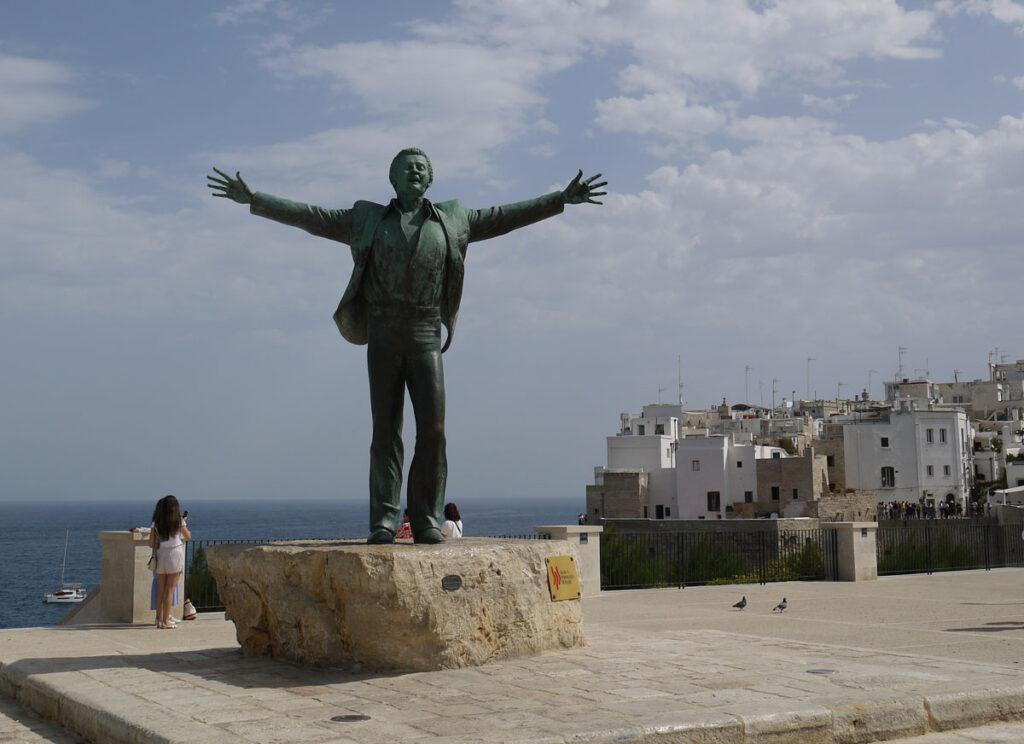
Modugno was born here in Polignano a Mare in 1928, and the town is very proud of their son, a big cultural figure in Italy. The dramatic clifftop statue of Modugno, ‘flying’ with arms outstretched, is an essential stop on tours for Italian visitors. You may notice other tributes to the performer as you explore the town: song lyrics engraved on stone benches near the statue; miniature copies of the statue on display. When I visited, a street (Via Roma) was strung with the words of ‘Volare’ in lights.
The terrace where the statue is located on Lungomare Domenico Modugno is a viewpoint that shouldn’t be missed. Steps lead down to flattish expanses of rock, where more views can be enjoyed. It’s a place to get some space in the sea air, look at the town on its headland, and watch swimmers in the water or diving and jumping from the cliffs.
Italian speakers with access to RaiPlay TV might enjoy a miniseries about Modugno with 1950s settings and scenes shot at Polignano: Volare – La grande storia di Domenico Modugno.
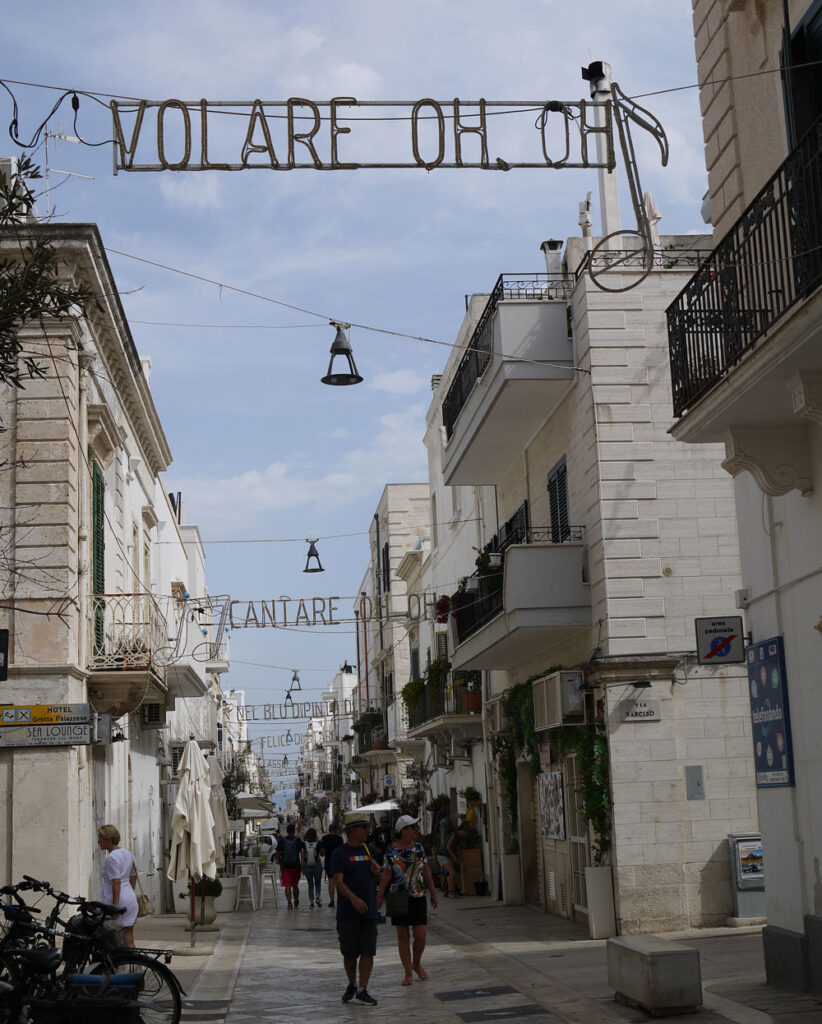
Along the coast to San Vito
If you’re a fan of the picturesque, I’d strongly recommend taking a trip along the coast to the Abbey of San Vito (Abbazia di San Vito), even if you’re not planning to take a boat trip from the site. This seafront abbey (not open to the public) is gorgeously shabby-picturesque; like Lama Monachile, you may have seen this on screen or in photos. Local boat trips depart from here, there are a couple of places to eat, and there’s good bathing/paddling on the coast.

Polignano on screen
Polignano and San Vito feature on screen in the Netflix film Jumping from High Places; the Lama Monachile setting and the sight of cliff divers plays a part in the storyline (read my guide to Jumping from High Places filming locations). The Italian TV drama about Domenico Modugno referenced above includes a few locations here, including the clifftops where the singer-songwriter’s statue now stands. And another chance to admire the Polignano scenery is the Italian movie Io che amo solo te.
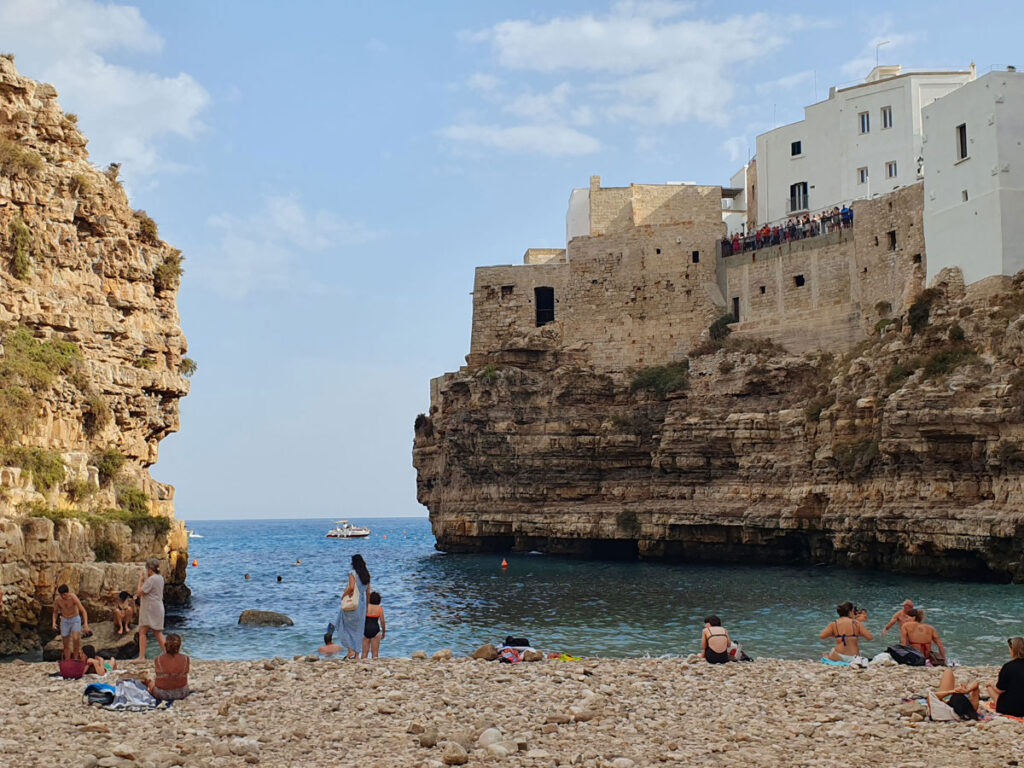
Eating and drinking
There’s a large number of welcoming places to eat and drink in Polignano, mostly dotted around the historic centre and along Via Roma nearby. Free drinking water is available from street fountains, including one at the corner of Via San Benedetto and Via Muraglia, and another in Piazza Garibaldi outside the town walls, where there is also a regular stall selling olives and taralli.
The Super Mago del Gelo over the road from the Arco Marchesale is a good stop for coffee, pastries, gelato and granita. Not far away in Piazza Aldo Moro is Pescaria, a popular and packed seafood-and-panini eatery (be prepared to queue). A cheap and quick fast-food option I found was Frumè on Via Roma, a takeaway with a few tables which sells focaccia and pizza slices.
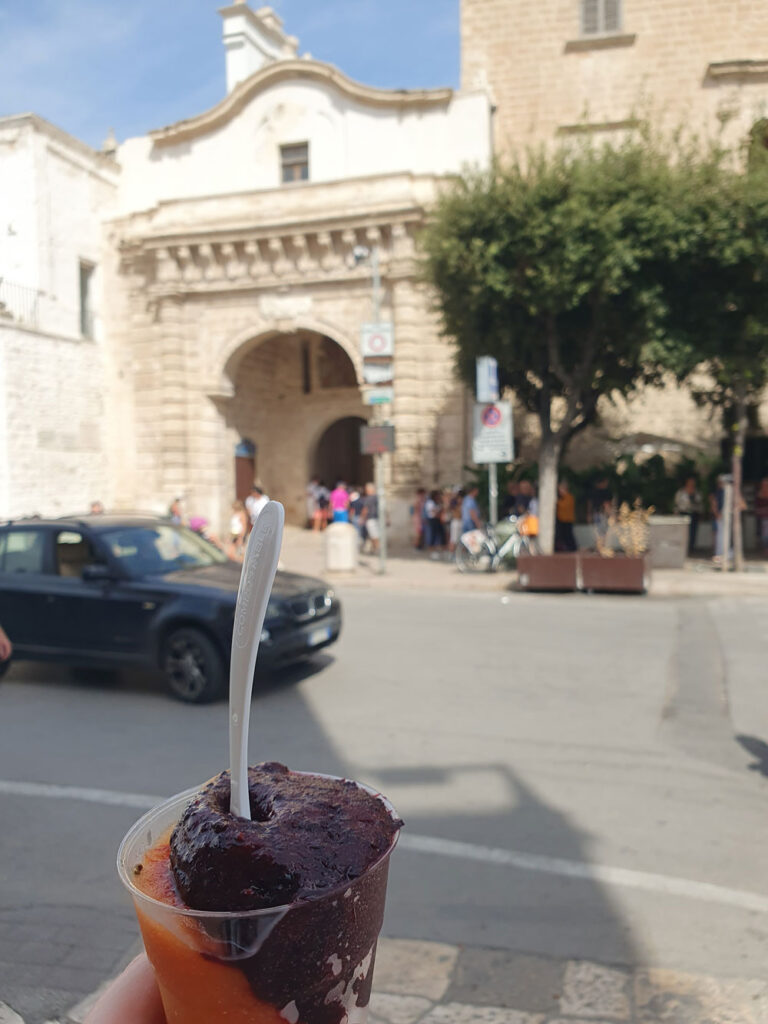
When to visit Polignano a Mare
As Polignano can get very crowded, the peak summer months of July and August are better to avoid if you have a choice when planning your trip. However, with sea breezes, boat trips and bathing spots, this stretch of coast is not a bad choice of location if you’re in Puglia at this time of year.
The town will be busy, but with a lot of added interest, during the festival of Polignano’s patron saint, San Vito, from 14th-16th June, and on dates when the Red Bull diving competition is held here (in summer; check their calendar).
Ideal times to enjoy the sunshine here are the shoulder seasons before and after the summer peak, and mid-week rather than weekends: May-June, and September-October. Do bear in mind, though, that while you will miss the main Italian holiday season, these are still extremely popular times of year for international travellers to visit Puglia.
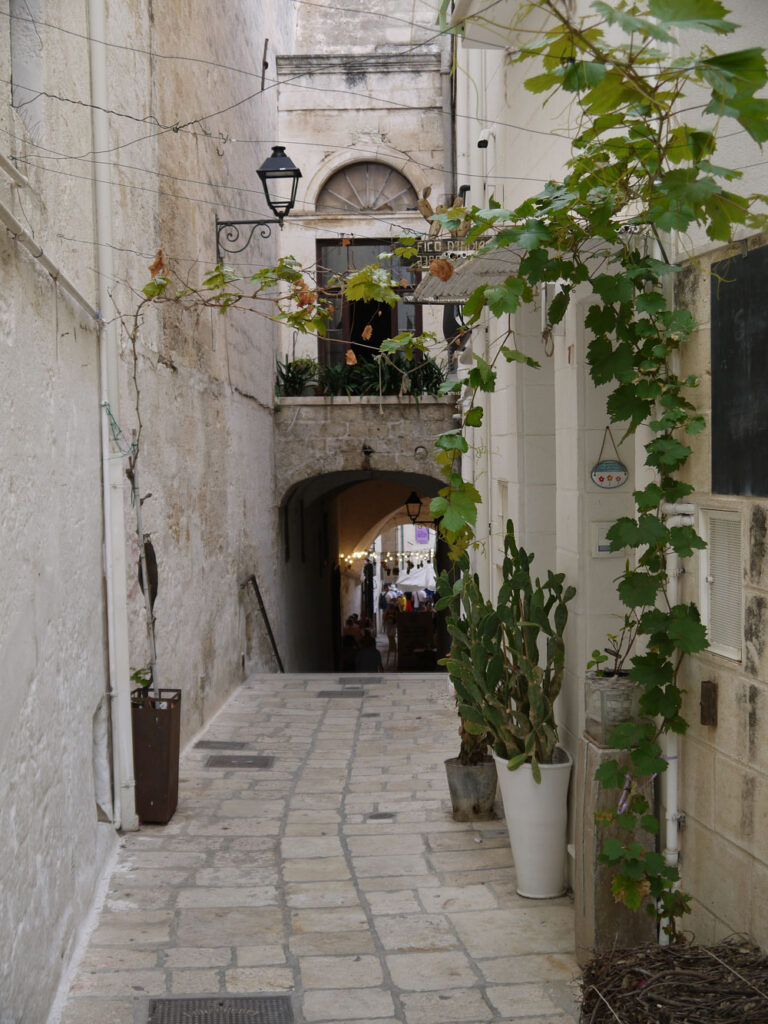
Polignano travel information
In a region where public transport links can be tricky, Polignano is fairly well-connected. The town has a station on the railway line heading south from Bari to Lecce. The station is on the edge of town, but it’s only a short walk to the historic centre, walking to the left along Viale Trieste and turning right up Via Martiri di Dogali, which takes you past the tourist office. An alternative route is via Viale delle Rimembranze opposite the station.
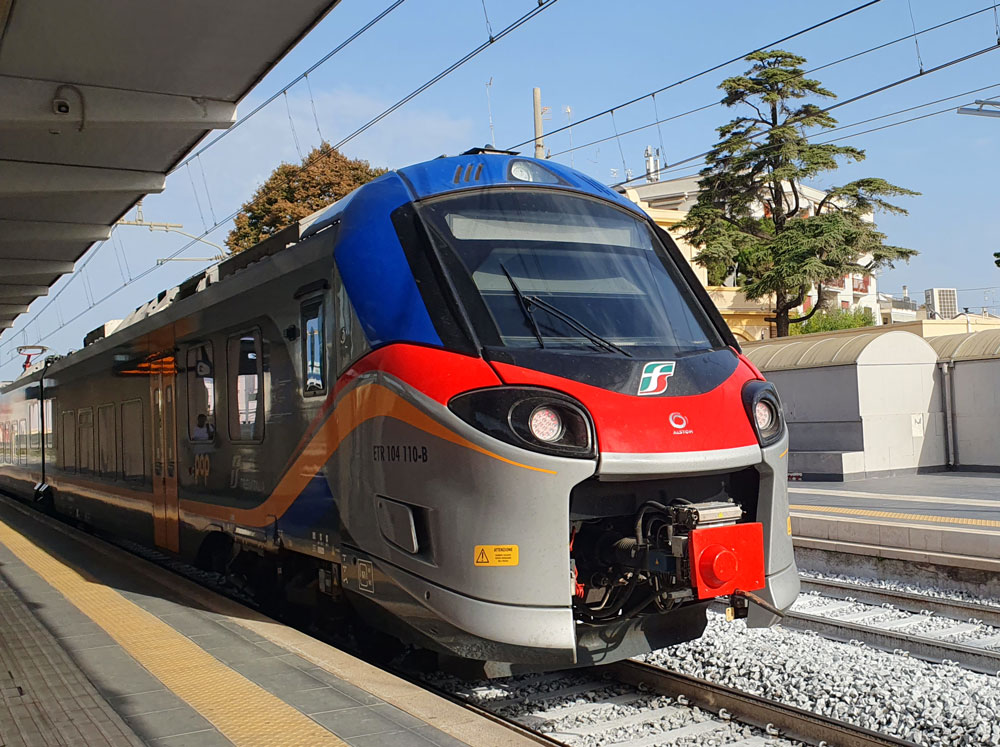
The closest airport to Polignano is Bari Airport, though Brindisi Airport is not much further away. It’s straightforward to reach Polignano from both airports by public transport, usually requiring only one change.
From Bari Airport, take the Ferrovie Nord Barese train to Bari Centrale, then change to the mainline FS service from Bari Centrale to Polignano a Mare (see Trenitalia for train times and prices – there are generally a couple of trains an hour). Journey time between Bari Centrale and Polignano varies from 23 minutes upwards; note that while most trains on this route are regional or fast regional trains (indicated by R and RV on timetables), with the same cheap prices, other categories of high-speed and longer-distance train are more expensive; make sure you have the right ticket for your service.
From Brindisi Airport, take the airport bus to Brindisi station, then a train to Polignano a Mare. Regional trains may require a change: check timetables and train tickets in advance, as per the paragraph above. Total travel time from the airport ranges from an hour and twenty minutes to just over two hours.
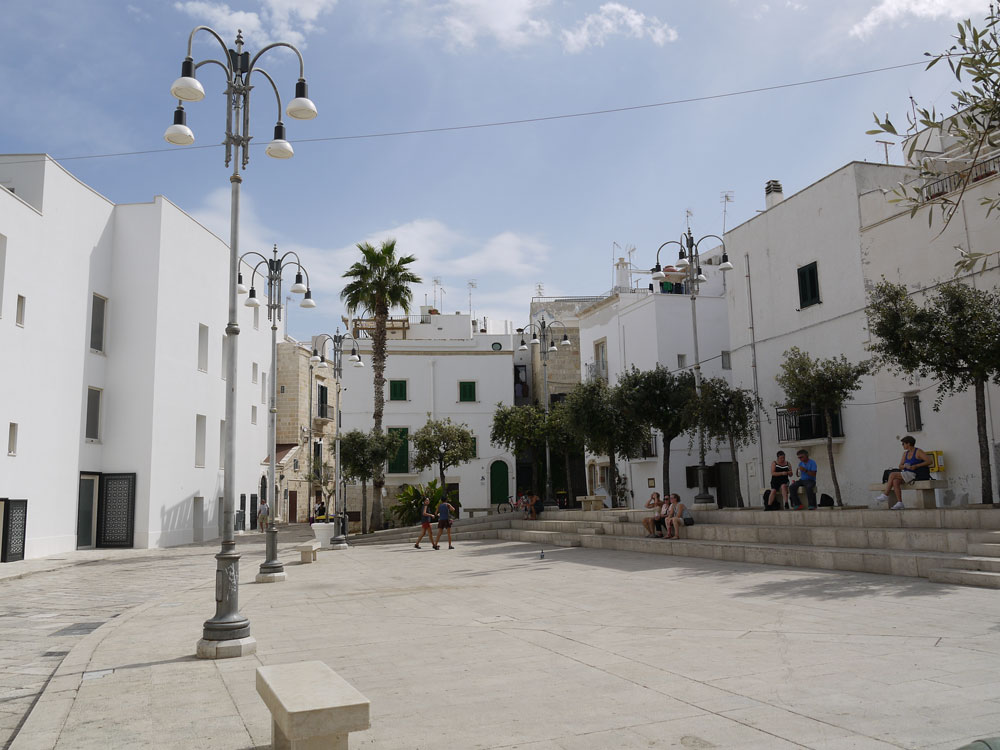
Buses also connect Polignano with the surrounding area, with services to destinations including Conversano and Monopoli (though Monopoli is more conveniently reached by train). Bus timetables are not always published online, and are sometimes confusing to interpret, especially to the outsider uncertain of school timetables (around which some bus routes are programmed), bus stop locations or where to buy tickets. I’d recommend researching online when you’re in the planning stages but also asking at the local tourist information offices for up-to-date details once you’re in Puglia – I’ve found these excellent at supplying timetables and advice. Buses can be rare and infrequent, so plan your day carefully.
There’s a bus stop close to the town walls in Piazza Garibaldi; this is where I caught a bus service to Conversano, having purchased my ticket in advance at Bar Dogali on Via Martiri di Dogali. This service, at the time of writing is run by FSE, the railway company, and timetables can be found on the Trenitalia website.
Taxi versions of Italy’s famous three-wheeler ape truck offer a fun and cheerful way to travel around Polignano and its immediate vicinity. You may find several outside the station and alongside Lama Monachile; they can also be ordered by phone, and take card payments.
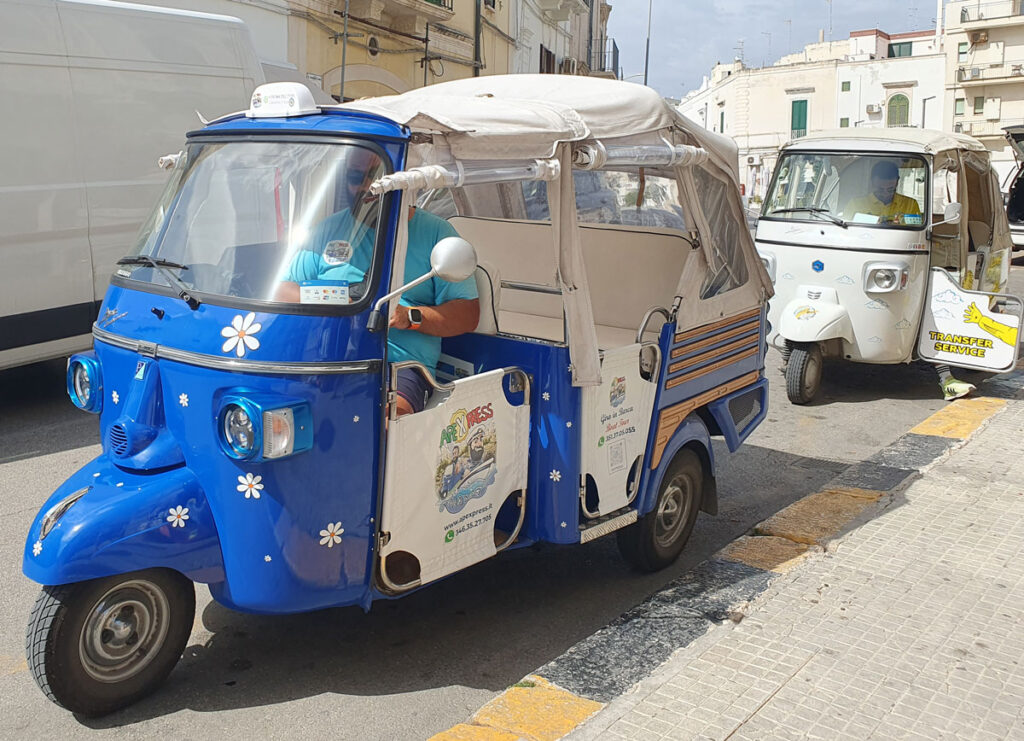
Is it worth visiting Polignano a Mare? Is it too touristy?
Is it worth visiting Polignana a Mare? I’ll be honest and say my initial one-word write-up on the day was ‘rammed’. It was more than ten years since I’d visited Puglia and I was shocked. It was mid-late September and the town was crowded with holidaymakers, the main lanes hard to get down due to the crush. It felt like a Disneyland. And unfortunately too many tourists here were at the extreme end of cultural insensitivity: I saw numbers of foreigners walking around the town in swimwear (considered offensive in Italy) and even saw a man at an restaurant table with a bare torso.
However, the Lama Monachile bay is truly dramatic and beautiful, and the visiting crowds do bring a picturesque life to the waters and cliffs. It would be a shame to miss this sight, which has become one of the most iconic images of Puglia. And the centro storico is genuinely attractive. Even when the town gateway, beach, piazza and a couple of lanes were packed, I did find quieter corners and views once I started exploring off the main routes, as you can see from my photos.
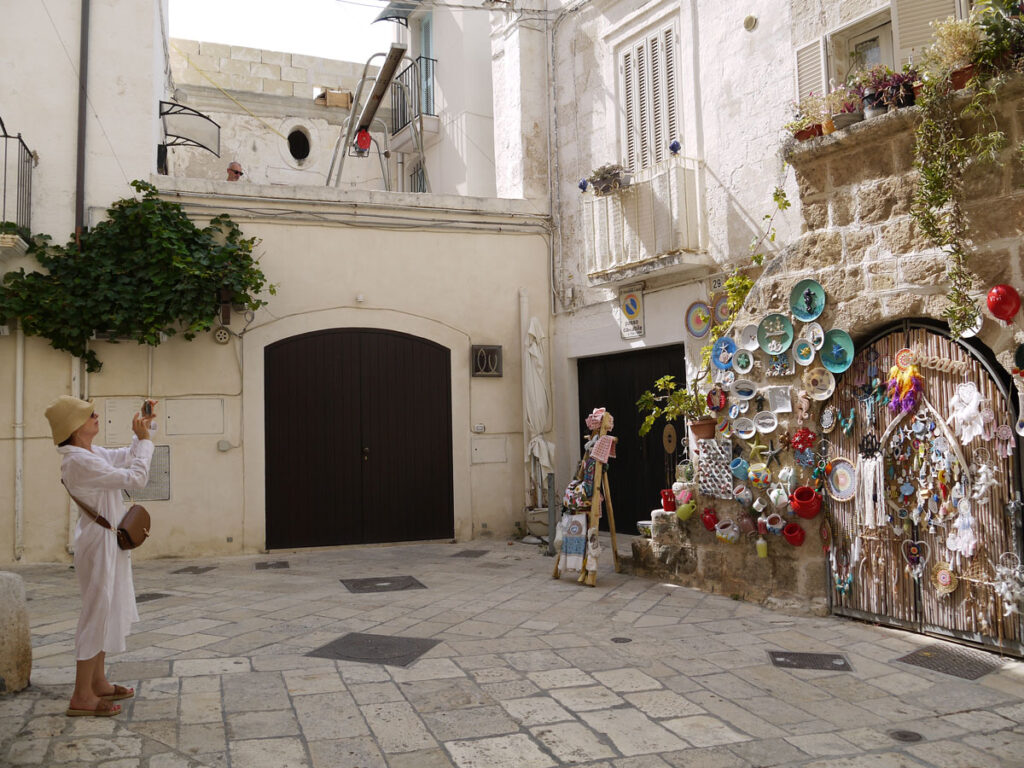
I prefer the sense of a real town with a local life, but it’s undeniable that many tourists enjoy the presence of souvenir shops, other tourists, and a big choice of restaurants and businesses aimed at outsiders. There’s also the argument that one or two busy tourist honeypots in a region bring in local revenue while leaving other locations unspoiled (I’m a bit doubtful about this, as tourism is such a growing market, but it’s a really complex issue).
In summary: even if Polignano sounds too touristy for your tastes, I’d suggest you do still consider visiting, especially if you can manage a quiet time of day or year. It is worth it to appreciate the views and the historic centre. Having an idea of what to expect will minimise disappointment, and strategic planning may be a decent compromise. For example, you could plan a day so you’re dipping into the hubbub only briefly, early in the morning, or you could stay here for a few nights, enjoying the scenery when the day-trippers aren’t around, and spending middays elsewhere.
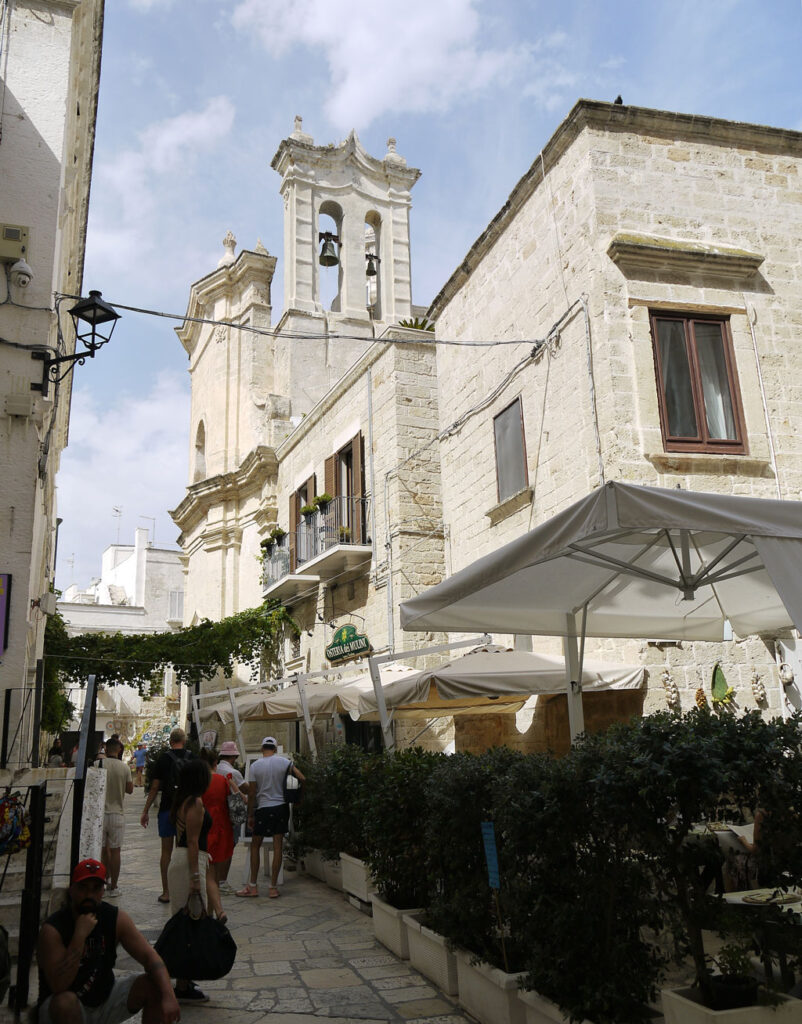
Recommending other towns as quieter alternatives risks spreading the problems further! But if you wish to skip Polignano or limit your time here, you will find other, less visited historic towns along the coast and inland. None with quite the same dramatic punch as the Lama Monachile scenery, however.
I visited by public transport and combined Polignano with San Vito and inland Conversano, which came as a quietly refreshing tonic. I’m glad I’ve seen Polignano but also glad I mixed it in with a range of other destinations in Puglia
Stay in Polignano a Mare
Polignano a Mare is a popular place to stay for independent travellers. It’s well-connected by road and public transport, and its position on the coast between Bari and Lecce means it fits in well with a variety of itineraries. With a big choice of places to eat and drink, and character-filled lanes to wander in the evening, the town has a lot going for it as a holiday base. As I suggest above, staying overnight here may offer the chance to enjoy the scenery when day-trippers aren’t around.
The best places to stay in and around Polignano tend to be B&Bs and guesthouses in the historic centre, some with clifftop sea views. There’s also some luxurious accommodation – villas, hotels and historic masserie – in the surrounding countryside, where you’re more likely to find swimming pools and space. Holiday rental apartments are dotted through the old town and newer areas for those fancying a more independent stay
As there are only a finite number of sea-view terraces and balconies in the historic buildings of the town centre, and B&Bs are mostly small and boutique, I’d recommend booking well in advance of your travel to get the best range of options and prices.
San Michele Suite in the old town has rave reviews and views overlooking Lama Monachile, as does A Casa di Dany, where the two suites are poised above the beach. Other options with views and terraces include Aquamarea and Amoredimare, which offers apartments and rooms with views out to sea, and a shared terrace. Dimora Anderì is a popular little old town B&B, where one room has a picturesque roof terrace.
Options outside town, for a more peaceful rural stay, include Masseria del Crocefisso and Masseria Le Torri.
The Polignano hotel with the best views is the Covo dei Saraceni. Looking out over Lama Monachile to the centro storico, it’s in a prime location – but do read guest reviews before booking.
Accommodation bookings made through these links will earn a small amount of commission for this site, without you paying any extra. This is what enables me to keep Italy Heaven online. If you’ve found my articles helpful, you could alternatively consider ‘buying me a coffee’ through the link at the foot of this page. Thank you for your support.
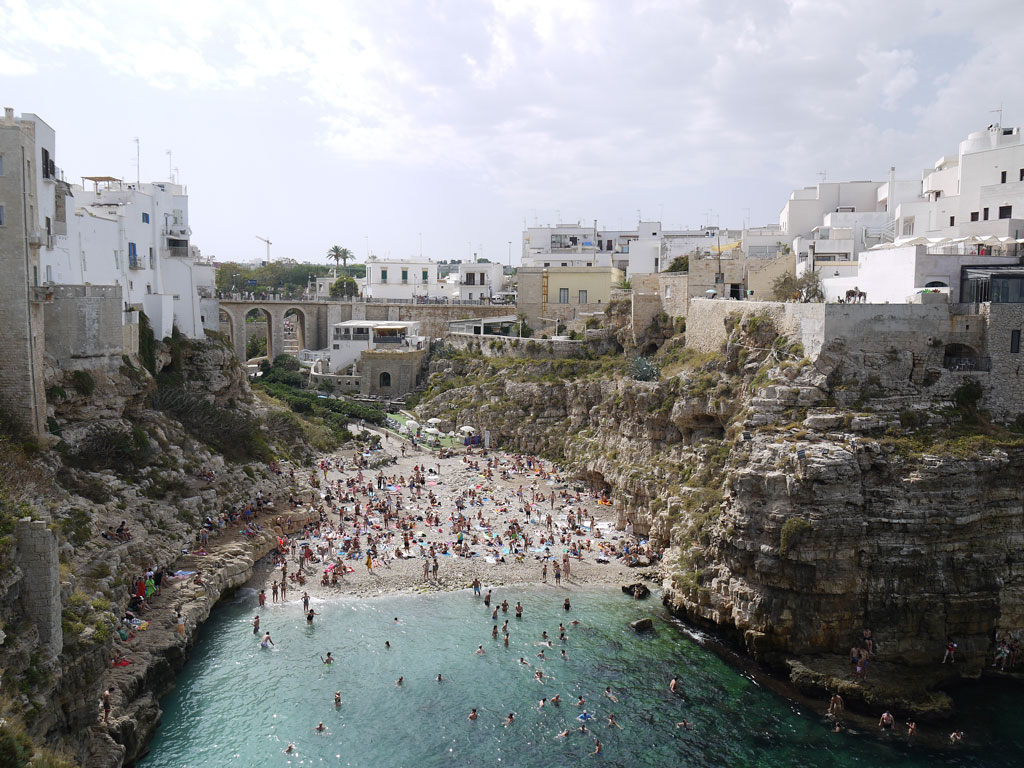
Around Polignano
There are beaches and bathing spots along the coast in both directions from Polignano, including at the picturesque Abbazia di San Vito, described above. The attractive town of Monopoli is just a few minutes away by train (note that in both towns the railway station is a walk away from the town centre).
The destinations which are worth visiting from Polignano a Mare vary depending on whether you are driving, how far you are happy to drive, or whether you are car-free. In addition to Monopoli, other good sights in the area include Alberobello and the other towns of the Valle d’Itria, the huge cave system at Castellana Grotte and pretty inland Conversano. Bari is an easy rail journey away and has lots to explore including the famous ‘Street of the Orecchiette’ and a good archaeological museum.
Longer excursions which are feasible by public transport, possibly with a change of trains/buses include trips to Lecce, Brindisi, Ostuni, Barletta and Trani.
